Are Hawks Endangered? Exploring Their Conservation Status
Hawks are a group of over 200 species of diurnal or active during-the-day birds of prey that are widely distributed and vary greatly in size. They have sharp eyesight, hooked beaks, and taloned feet for hunting.
Most hawk species are listed under different levels of being endangered, from least concerned species to critically endangered, depending on their population. Communities, NGOs, government agencies, and wildlife conservancy agencies have embarked on efforts to preserve their habitats and environment.
Hawks are essential in the ecosystem as they help control the population of rodents, squirrels, rabbits, and other small animals. They are top of the food pyramid and hence considered birds of prey or raptors. They feed on small animals to balance their population, preventing the depletion of natural resources.
In this guide, we will discuss the status of different types of hawk species in detail. So, read on to learn more.
What Does “Endangered” Mean In The Context Of Wildlife Conservation?
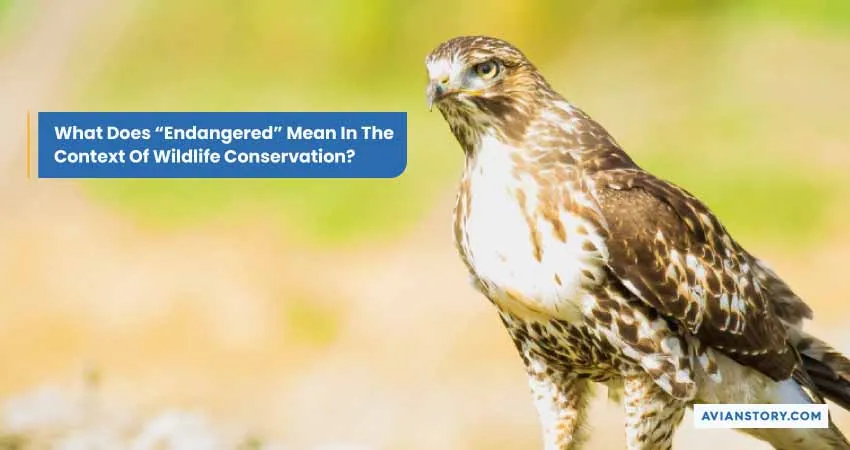
In the context of wildlife conservation, endangered species means any species in danger of extinction throughout its population range in most of its habitat.
Endangered species are categorized into the following sub-groups;
- Critically endangered: They face an extremely high risk of extinction in the natural environment
- Endangered: These species face a very high risk of extinction in the wild
- Vulnerable: These species are considered to face a high risk of extinction in the wild
For a species to be considered endangered, it undergoes a crucial assessment to help in its grouping, including questions such as;
1. What is the condition of the habitat? – Whether their natural habitat is under threat from human activities such as logging and pollution leading to habitat loss.
2. Is the habitat shrinking, and if yes, how fast is the shrinking process? – It is important to check the trend in the population growth of a species, whether they are increasing or decreasing. The shrinking rates help classify these species appropriately.
3. What is the population of the species in that habitat? The entire population of a certain species is important to consider.
A certain species might be declining/shrinking at a fast rate, but the overall population is huge enough to cover for the deficit. Their reproduction rate is also to be considered.
4. Is the population dropping, and if yes, how fast is the dropping rate? – Fast-dropping rates will classify that species as critically endangered, while a slight decrease will categorize them as vulnerable.
When a species is listed as endangered, it is accorded legal protection under the Endangered Species Act. Under the Act, hunting, harming, or killing endangered species is illegal.
Government and conservative agencies also prioritize endangered species for conservation efforts. The focus is on habitat restoration and captive breeding to help the species recover and remove them from the endangered species list.
Are Hawks Currently Classified As Endangered?
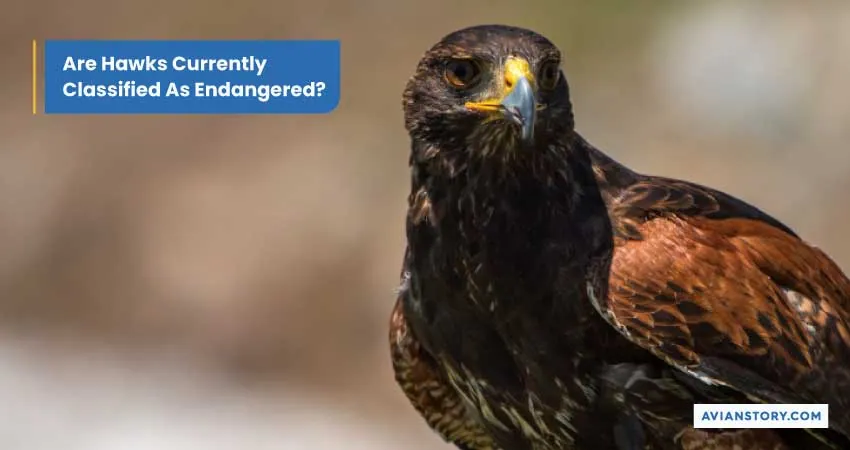
According to international organizations such as the IUCN Red List for endangered species, different hawks are categorized under various extinction levels.
Below are the common hawk species and their classification under the IUCN red list.
| Hawk Species | Statuses According To the IUCN Red List |
| Red-tailed Hawk (Buteo jamaicensis) | Least concern |
| Ridgway’s Hawk (Buteo ridgwayi) | Critically endangered |
| Cooper’s Hawk (Accipiter cooperii) | Least concern |
| White Necked Hawk (Buteogallus lacernulatus) | vulnerable |
| Red-shouldered Hawk (Buteo lineatus) | Least concern |
| Rufous Crab Hawk (Buteogallus aequinoctialis) | Near Threatened |
| Sharp-shinned Hawk (Accipiter striatus) | Least concern |
| Gray Backed Hawk (Pseudastur occidentalis) | Endangered |
| Hawaiian Hawk (Buteo solitarius) | Near Threatened |
Ridgway’s hawks are the most critically endangered hawk species, with less than 500 Ridgway hawks left worldwide.
In New Jersey, Red-shouldered Hawks are considered endangered, with 200 pairs remaining in the state.
What Are The Main Threats To Hawk Populations?

Like any other wild bird of prey, hawks have threats from other larger and stronger birds and animals. In the wild, the hawks’ population is under threat by the following predators.
Owls
Owls are known to hunt small and weak hawks in the wild since they are large and more powerful than most hawks. Their target is the young hawks left in their nests by their mothers.
Eagles
Eagles are also a key threat to the Hawks’ population as they take Hawks down for food. Mature eagles are seen hunting small hawks for territories and usually kill with their strong talons and beaks.
Eagles are strong and have a powerful flight capacity with their broad wings. They also use their sharp and strong sight to attack unaware hawks.
Raccoons
Raccoons may not directly attack hawks but rather attack their nests, eating eggs and young hawks. Raccoons also fight with the hawks for territory and nesting sites.
Red Foxes
Red foxes hunt and catch unaware hawks as they forage on the ground. The red foxes are fast enough and attack hawks from behind. They may also climb trees and feed on the hawks’ eggs and young ones.
Coyotes
In open fields, coyotes are seen hunting for hawks as they try to catch their prey. Coyotes hunt for hawks in groups to increase their hunting capacity.
Coyotes also attack hawks’ nests for eggs and their young hawks that are weak and helpless.
Snakes
Large snakes may climb trees and attack hawks’ nesting sites for eggs and the young hawks. Some snakes also camouflage with the trees and attack hawks while resting on the tree branches.
Larger Hawks
Surprisingly, larger hawks, such as Red-tailed hawks and Cooper’s hawks, also attack other smaller and vulnerable hawks from other groups, such as Sparrow hawks. Hawks fight for territories and nesting areas where the strongest hawks survive and kill the others.
Such relationships with other animals and birds of prey reduce the hawks’ population greatly in the wild. Birds of prey, such as eagles and owls, compete with hawks for nesting sites, territories, and prey.
Human-Related Threats And Their Consequences
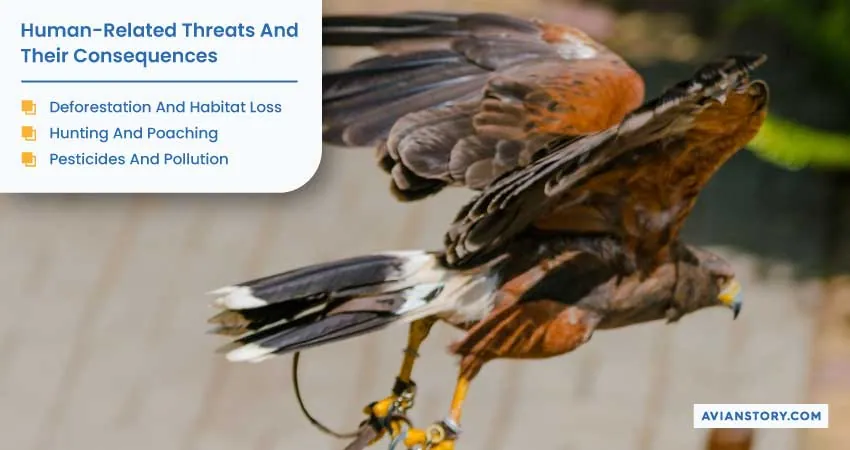
Apart from the threats from fellow birds of prey and wild animals, humans also greatly threaten these raptors through their day-to-day activities.
Common human activities that greatly affect these raptors’ population include;
Deforestation And Habitat Loss
Human activities have adversely affected the hawks’ population through deforestation. As humans advance their settlement and cultivation in areas that host these birds, they cut down trees, leading to hawks’ habitat loss.
Continued deforestation in hawks’ habitats causes a decline in their population as they continue competing for territories and nesting areas.
Hunting And Poaching
Second to habitat destruction is the hunting and poaching of hawks by humans for their feathers used in traditional ceremonies and related rituals.
Hunting and poaching of hawks are illegal in most countries since they reduce the hawks’ population at an alarming rate.
Pesticides And Pollution
Human activities, especially the use of chemicals in the agriculture sector, have adversely affected the hawks’ population, especially in rural areas. In the urban areas, pollution through greenhouse gasses and other pollutants also affects the hawks’ health, reducing their population.
Pesticides and pollutants cause reproductive problems such as thinned eggshells and respiratory problems in hawks.
How Have These Threats Affected Specific Hawk Species?

For a more detailed assessment of the impact of these threats on hawks’ population, let’s look at specific hawks’ species.
1. Red-tailed Hawks are one of the greatly affected species by the chemicals from pesticides and pollution. The Red-tailed Hawks feed on small mammals, reptiles, and birds previously fed on contaminated crops and forage.
Chemicals such as DDT in pesticides and lead contamination in rodents also affect Red-tailed Hawks due to their scavenging nature on contaminated meat.
2. Sharp-shinned Hawks are forest birds that require dense forest cover for nesting and foraging. Deforestation can have a significant impact on their populations.
When forests are cleared, the hawks lose their habitat and food sources. This can lead to population decline.
3. Cooper’s Hawks feed mostly on birds and small mammals. They hunt by stealth, approaching their prey through dense cover and then pouncing with a rapid, powerful flight.
Hunting and poaching of Cooper’s Hawks can significantly reduce their populations.
4. Gray-backed hawks have increasingly suffered from habitat loss due to continued deforestation of the deciduous forests and humid evergreen forests.
These forests serve as their preferred habitats but also are a source of timber for human activities.
5. The Ridgway’s hawk species are affected by continued hunting and trapping of terrestrial animals, logging, and wood harvesting, leaving them endangered.
What Impact Does The Decline Of Hawk Populations Have On The Ecosystem?
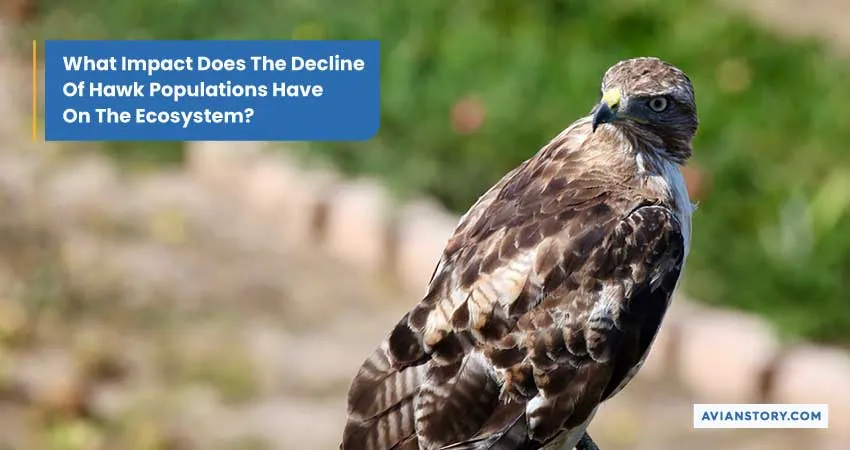
Hawks play an essential role in maintaining balance in the ecosystem. Large hawks feed on small birds and mammals, thus controlling their population to prevent an excess of a species that would destroy natural resources.
For example, hawks control the population of doves in an area as they fight and feed on them. Such relationships prevent resource depletion and competition for nesting sites.
With the increased threats toward hawk species, there is a huge risk of ecosystem imbalance. For example, a decreasing hawk population leads to an increase in doves and other mammals and rodents such as squirrels and rabbits.
These rodents and doves increase in population and threaten the growth of forage crops and cereals due to rapid attack by their huge population.
Such activities translate into reduced produce harvest, which affects the human population. Other mammal populations, such as rodents, can also spread diseases to humans, like Hantavirus, Leptospirosis, Lassa Fever, etc.
It’s, therefore, important to control each species to ensure a balanced, self-sustaining ecosystem.
What Are The Current Conservation Efforts For Hawks?
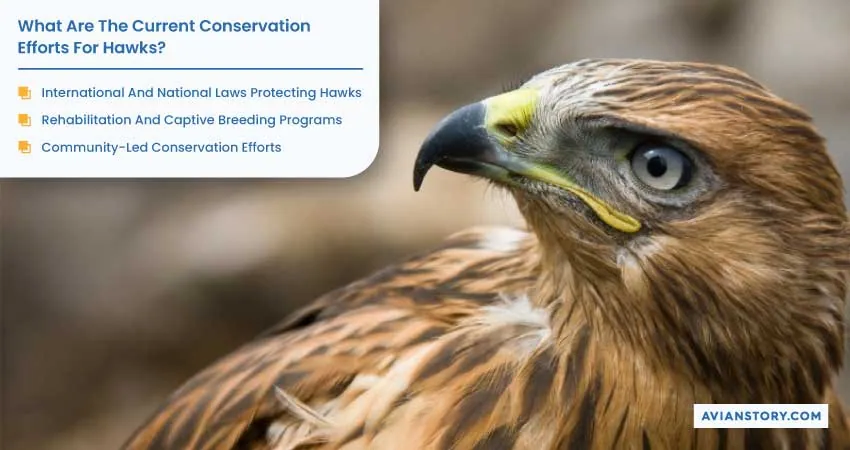
With the increased threats to hawks, there have been several current conservation efforts for hawks from extinction. These efforts cut across various groups, such as:
International And National Laws Protecting Hawks
International and national laws aim to prevent continued hunting, poaching, and use of chemicals that harm hawks. These include
- The Migratory Bird Treaty Act (MBTA) protects hawks in the world from poaching during their migration.
- Monitoring and research efforts by research institutes funded by the national governments.
- Federal laws that protect hawks from illegal shooting. These laws vary from one state to another and include the requirement for hunting licenses and permits.
Rehabilitation And Captive Breeding Programs
Rehabilitative efforts by individual groups, such as captive breeding and reintroduction into the wild. Other programs include habitat protection and restoration for birds of prey.
Such efforts were championed by organizations such as;
- World Wildlife Fund (WWF)
- Conservation International (CI)
- Wildlife Conservation Society (WCS)
- Zoological Society of London (ZSL)
- Mauritian Wildlife Foundation (MWF)
- Durrell Wildlife Conservation Trust (DWCT)
Community-Led Conservation Efforts
The community is vital in the conservation of hawks through government and NGO support in programs such as
- Educating the community on the need to conserve hawks and other birds.
- Involving them in the protection and restoration of habitats.
- Training communities on safe agricultural methods.
Currently, community-led conservation efforts aimed at protecting and preserving these endangered species include
Habitat protection – The Conneaut communities along Cleveland in Ohio that live around major hawks’ habitats and hawkwatch locations are engaged in the protection of hawks’ habitat. Indigenous trees that serve as perching points are protected from illegal logging.
Reducing pollution – Sikh community in West Indies that live within these endangered hawk species are actively engaged in awareness creation about the effects of pollution.
They have also introduced regulations and laws to reduce environmental pollution to safeguard these endangered species especially the Northern Goshawks.
Reducing hunting of endangered hawk species – Communities such as the Oregon and Colorado hunting groups have now shifted their hunting from hawks in the United States to other animals that have a high population and are least concerned, according to the IUCN red list.
What Can We Do To Help Preserve Hawk Populations?
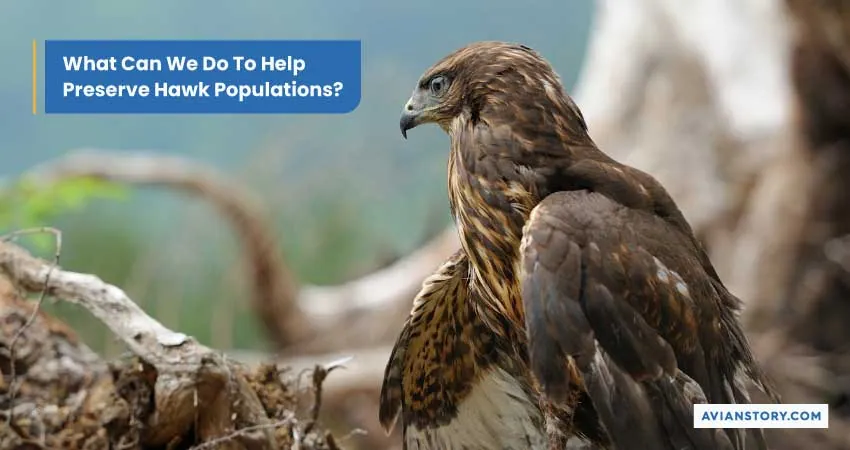
Hawks are essential species in the environment since they help balance the ecosystem through the prey and predator relationship. It is, therefore, necessary to preserve their population from extinction since most of them are endangered.
Humans can adopt the following lifestyle changes to preserve the Hawks’ population.
- Reducing the use of pesticides and herbicides, as these chemicals can harm Hawks.
- Reducing carbon footprint by driving less, using public transportation, or biking
- Supporting sustainable agriculture practices that protect wildlife habitat.
- Reducing your use of single-use plastics, which can harm hawks’ lives.
Humans can also support conservation organizations that work to protect hawks and their habitats by;
- Joining different birds and hawk conservation groups and organizations.
- Working together in programs aimed at conserving and protecting hawks, such as the Bird Conservation Agency.
- Supporting the Hawks Conservancy Trust Agency through donations.
Conclusion
Hawks are essential in balancing the ecosystem, and preventing resource depletion and competition by other bird species. Most of the hawks’ species are endangered or at the edge of being endangered soon if conservation measures are not adopted.
Therefore, our collective responsibility is to conserve and protect these rare species as they are instrumental in balancing our ecosystem. We can join and support conservation agencies and organizations in safeguarding the hawks’ species.
